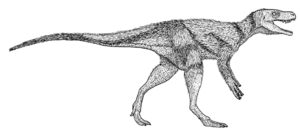Paleontology in Arizona facts for kids
Paleontology in Arizona is all about finding and studying ancient life in the state of Arizona. Imagine a time long, long ago when Arizona looked very different! It was once covered by a shallow sea, home to strange creatures like jellyfish and tiny, mat-forming bacteria called stromatolites.
Over millions of years, this sea came and went. When it was here, creatures like brachiopods (shellfish) and trilobites (ancient sea bugs) swam in its waters. Later, Arizona became a land of lush forests where dinosaurs roamed. It also had huge sand dunes where dinosaurs left their footprints. Parts of Arizona were even covered by a giant inland sea, home to amazing marine reptiles like plesiosaurs and turtles.
After the dinosaurs, Arizona became dry land. Giant camels, horses, mastodons, and huge giant ground sloths lived here. People have been finding these fossils for a long time. Native Americans even had special stories about them. Scientists started studying Arizona's fossils in the mid-1800s. Some of the most famous finds include the amazing Petrified Forest, ancient fossil footprints, and even pterosaur (flying reptile) footprints! The state fossil of Arizona is a type of ancient tree called Araucarioxylon arizonicum.
Contents
Ancient Arizona: A Journey Through Time
Life in the Precambrian Seas
Long, long ago, in the Precambrian era, Arizona was covered by a shallow sea. This was a time when life was just starting to get complex. Tiny stromatolites, which are mounds made by bacteria, grew in these ancient waters.
Even more exciting, fossils of jellyfish from the Proterozoic part of the Precambrian have been found in the Grand Canyon. These are some of the oldest jellyfish fossils ever discovered!
Paleozoic Era: Seas and Early Land Plants
During the Cambrian period, Arizona was still covered by a shallow sea. Creatures like brachiopods and trilobites lived here, leaving their remains in the western part of the state.
The sea then pulled back during the Ordovician and Silurian periods. Because of this, we don't have many fossils from these times in Arizona. But the sea returned during the Devonian period. This time, brachiopods, corals, and even early fishes swam in Arizona's waters.
Later, in the Carboniferous period, sea levels went up and down a lot. When the water was low, much of Arizona became a rich, green coastal plain. Plants from the Mississippian period left behind many fossils. Near the end of the Permian period, the sea covered Arizona again. Many different kinds of plants grew here during the Permian, leaving fossils in places like the Grand Canyon.
Mesozoic Era: Dinosaurs and Flying Reptiles
The Mesozoic era began with changes in Arizona's land. During the Late Triassic period, water flowed across the land towards the ancient supercontinent Pangaea. Arizona's environment was similar to what is now Texas.
Fossils of Triassic plants like clubmosses and ferns have been found in the Painted Desert and Petrified Forest. Amphibians lived here too, leaving fossils near Meteor Crater. Early relatives of mammals called dicynodonts left remains near St. Johns.
Arizona is also famous for Chindesaurus fossils. This dinosaur is important because it shows a link between local animals and some of the earliest dinosaurs found in South America. Other creatures like the crocodile-like Rutiodon also lived here.
During the Jurassic period, much of Arizona was covered by huge sand dunes. Dinosaurs left their footprints in these sands. One large dinosaur found here was Sarahsaurus, an early long-necked dinosaur.
In the Cretaceous period, mountains formed in western Arizona. The sea returned to the eastern part of the state, bringing marine reptiles like turtles and plesiosaurs. On land, a huge long-necked dinosaur called Sonorasaurus lived in southern Arizona.
Cenozoic Era: Mammals and Modern Landscapes
Most of Arizona was dry land during the Cenozoic era. Many different animals lived here, including camels, horses, and mastodons.
During the Miocene period, camels lived in what is now Yuma County. In the Pleistocene period, Arizona was home to camels, mastodons, rodents, and giant giant sloths. Their fossils have been found in Graham County.
At one point in the Pleistocene, mastodons got stuck in a marsh in the San Pedro Valley. Their skeletons were found standing upright, just as they were trapped! As the Quaternary period began, Arizona's climate became drier, and many lakes and rivers disappeared.
Studying Arizona's Past
Scientific Discoveries
Scientists have been studying Arizona's fossils for a long time. In 1853, the first reports about Arizona's amazing petrified forest were written. In 1873, the Smithsonian sent a team to collect samples of the petrified wood.
By 1900, people were worried because so many fossils were being taken from the Petrified Forest. This led to it being declared a national monument in 1906, helping to protect these incredible fossils.
In 1915, Charles Schuchert found many fossil footprints at the Grand Canyon. Later, in the 1920s, Charles W. Gilmore from the Smithsonian collected more of these footprints, especially those from the Permian period, which are very common there. He even helped create an exhibit about ancient tracks at Hermit Trail.
In 1938, a fossil of a jellyfish was found in the Grand Canyon's ancient rocks. This was the oldest jellyfish fossil known at the time! In 1957, scientists described Pteraichnus, a type of fossil footprint likely made by pterosaurs (flying reptiles) in Arizona.
Places to Explore Ancient Life
Protected Areas
Famous Paleontologists
- Sterling Nesbitt was born in Mesa in 1982.
- Edwin Harris Colbert passed away in Flagstaff in 2001 at 96 years old.
- Paul S. Martin passed away in Tucson in 2010.
Natural History Museums
If you want to see Arizona's amazing fossils up close, check out these museums:
- Arizona Museum of Natural History, Mesa
- Museum of Northern Arizona, Flagstaff
- University of Arizona Mineral Museum, Tucson
- Pinal Geology and Mineral Museum, Coolidge
Events
- Tucson Gem & Mineral Show




